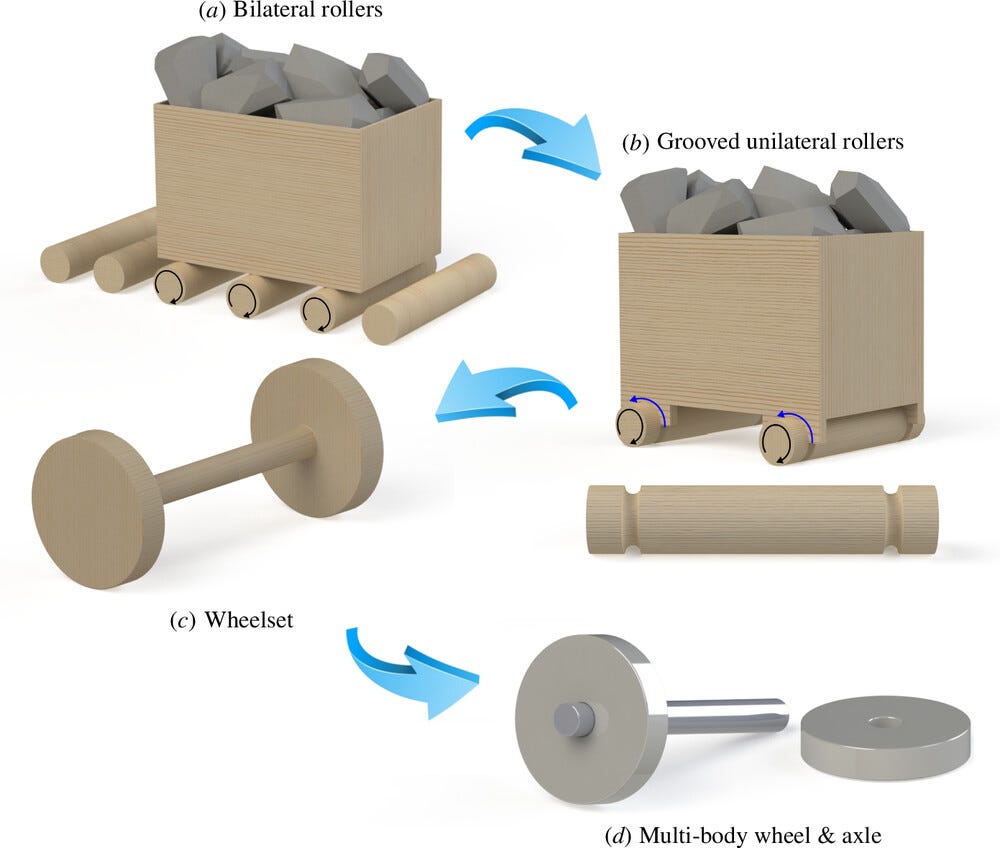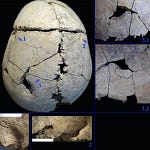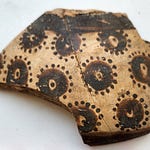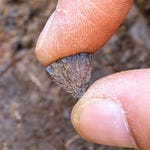The Wheel Was Not Born in a Day
The wheel looms large in the popular imagination as a spark of genius—perhaps the defining artifact of early human ingenuity. But how, exactly, does such a revolutionary device come into being? A new study1, led by aerospace engineers and historians, turns this question into a forensic design problem.
Instead of speculating in broad strokes, researchers Lee Alacoque, Richard Bulliet, and Kai James used computational simulations to reconstruct the physical and mechanical steps that may have led to the earliest wheels. Their findings point not to open plains or chariot warfare, but to the narrow tunnels of Copper Age mines in the Carpathians—where the first wheels may have slowly emerged from centuries of labor and friction.
“The mine environment,” the authors write, “offered the perfect selective pressures to encourage incremental improvements—from rollers, to grooved axles, to full wheelsets.”
From Rollers to Axles: A Sequence of Innovation
Long before wheels, people used simple rollers—cylindrical logs laid under heavy loads. In open fields, this method was clumsy. But in confined mining tunnels, where miners hauled ore in narrow spaces without beasts of burden, rollers offered a promising transport method that could be adapted.

Rather than constantly repositioning spent rollers to the front of a cart, miners may have developed unilateral rolling—a technique in which rollers were embedded into socketed vessels and pulled along with the cart. This allowed transport carts to remain aligned in tight corridors.
Eventually, wear and practical necessity could have prompted changes to the rollers themselves. Friction grooves, possibly accidental at first, began to appear. These grooved rollers evolved, perhaps by design or trial-and-error, into what we would recognize today as axles.
“Each step traded one form of mechanical difficulty for another,” explains the study. “But the progression was always toward better mechanical advantage—less energy input for more movement.”
The Simulated Evolution of the Wheel
To test whether such a transformation could happen through small, cumulative improvements, the research team built a physics-based design algorithm. Starting from a primitive roller, the model sought to optimize structures for both strength and efficiency. With each iteration, the simulated object evolved to better distribute force and reduce friction.
By the end of the process, the algorithm independently produced a fully formed wheel-and-axle—identical in principle to early archaeological finds from the Carpathian region.
“Our findings suggest that the wheel’s design could have emerged gradually, much like biological evolution, through environmental pressure and repeated selection for better performance.”
The Curious Case of the Wheeled Mug
The archaeological link to Carpathian mines isn’t just theoretical. Excavations have uncovered more than 150 miniature clay models of four-wheeled carts, shaped like mugs, dating to around 3600 BCE. These mugs appear to celebrate or commemorate wheeled ore-carrying devices. They feature loop handles, no harness points for animals, and stylized wicker textures that hint at baskets rather than solid carts.
“Why would people drink out of tiny wheeled mugs?” asks Bulliet in a separate analysis. “Because those carts mattered to them—they changed their work, their economy, and their social identity.”
An Invention Born of Constraint
The mine’s unique characteristics—tight, straight tunnels and the absence of animals—played a vital role in shaping the evolution of early carts. These constraints eliminated many design alternatives and focused human creativity on refining what was feasible.
Wheelsets, where the wheels and axle rotate as a single unit, performed poorly in turns. But in the straight passageways of mines, they worked just fine. What was a flaw in the open became an advantage underground.
“By tracing the wheel’s development through mine tunnels,” the study argues, “we see how environmental context can sculpt technological change, not unlike how evolution shapes traits through natural selection.”
The Wheel’s Long Road
This story challenges two common myths: first, that the wheel emerged fully formed from a singular spark of genius; and second, that ancient engineering was driven primarily by conquest and empire. Instead, it suggests a humbler origin—one born of necessity, labor, and quiet experimentation.
It also offers a model for how other technologies might have emerged—not all at once, but through slow, iterative change, in response to immediate and local challenges.
“Much like the wheel’s circular form, its history isn’t linear—it loops through trial, friction, and ingenuity.”
Related Research and Readings
Bondár, M. (2018). Prehistoric innovations: wheels and wheeled vehicles. Acta Archaeologica Academiae Scientiarum Hungaricae, 69(2), 271–297. https://doi.org/10.1556/072.2018.69.2.3
Bulliet, R. W. (2016). The Wheel: Inventions and Reinventions. Columbia University Press.
Osenton, C. J. (2001). Megalithic engineering techniques: experiments using axe-based technology. Antiquity, 75(288), 293–298. https://doi.org/10.1017/S0003598X00060932
Rao, J. S. (2011). History of Rotating Machinery Dynamics. Springer. PDF
Anthony, D. W. (2008). The Horse, the Wheel, and Language: How Bronze-Age Riders from the Eurasian Steppes Shaped the Modern World. Princeton University Press.
Alacoque, L. R., Bulliet, R. W., & James, K. A. (2024). Reconstructing the invention of the wheel using computational structural analysis and design. Royal Society Open Science, 11(10), 240373. https://doi.org/10.1098/rsos.240373









